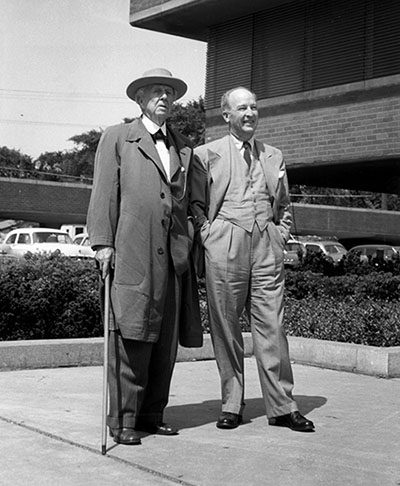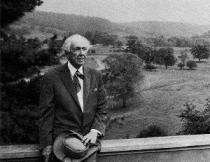Biography
Frank Lloyd Wright: Wisconsin’s Native Son,
This Country’s Greatest Architect
 Wisconsin's native son, Frank Lloyd Wright, spent more than 70 years at the drafting board creating designs that revolutionized the art and architecture of this century. Many innovations in today's buildings are products of his imagination. In all he designed 1,141 works, including houses, offices, churches, schools, libraries, bridges, museums and many other building types. Of that total, 532 resulted in completed works, 409 of which still stand.
Wisconsin's native son, Frank Lloyd Wright, spent more than 70 years at the drafting board creating designs that revolutionized the art and architecture of this century. Many innovations in today's buildings are products of his imagination. In all he designed 1,141 works, including houses, offices, churches, schools, libraries, bridges, museums and many other building types. Of that total, 532 resulted in completed works, 409 of which still stand.
However, Wright's creative mind was not confined to architecture. He also designed furniture, fabrics, art glass, lamps, dinnerware, silver, linens and graphic arts. In addition, he was a prolific writer, an educator and a philosopher. He authored more than a dozen books and countless articles, lectured throughout the United States and in Europe, and developed a remarkable plan for decentralizing urban America (Broadacre City) that continues to be debated by scholars and writers even to this day -- some 60 years after its conception by Wright.
Wright is considered by many to be the 20th century's greatest architect. Indeed, the American Institute of Architects in a recent national survey, recognized Frank Lloyd Wright to be "the greatest American architect of all time." Architectural Record magazine (one of the top three national magazines devoted to architecture) declared that Wright's buildings stand out among the most significant architectural works during the last 100 years IN THE WORLD.
To get a perspective on Wright's long and productive life, it is useful to remember that he was born in 1867, just two years after the end of the Civil War and died in 1959, two years after the launching of the first satellite Sputnik. Wright's Spring Green home, Taliesin, built in 1911, was initially lighted by gas lamps.
 Wright revered the American experience and believed that democracy was the best form of government. Throughout his life he strived to create a new architecture that reflected the American democratic experience, an architecture based not on failing European and foreign models (such as Greek, Egyptian and Renaissance styles) but rather an architecture based solely on America's democratic values and human dignity. He often referred to the United States as Usonia. The city plan, Broadacre City, was the culmination of Wright's ideas on a new architecture for a new democracy.
Wright revered the American experience and believed that democracy was the best form of government. Throughout his life he strived to create a new architecture that reflected the American democratic experience, an architecture based not on failing European and foreign models (such as Greek, Egyptian and Renaissance styles) but rather an architecture based solely on America's democratic values and human dignity. He often referred to the United States as Usonia. The city plan, Broadacre City, was the culmination of Wright's ideas on a new architecture for a new democracy.
Wright preached the beauty of native materials and insisted that buildings grow naturally from their surroundings. He freed Americans from the Victorian "boxes" of the 19th century and helped create the open plan with rooms that flowed and opened out to each other. By changing architecture and changing the way America lived, Wright may have had an even more profound effect. As Wright said, "Whether people are fully conscious of this or not, they actually derive countenance and sustenance from the 'atmosphere' of the things they live in or with. They are rooted in them just as a plant is in the soil in which it is planted."
The soil that sprouted Frank Lloyd Wright was the rural Wisconsin countryside. In the mid-1800's his Welsh ancestors settled the quiet river valley near Spring Green, Wisconsin, where Wright later built his famous home, Taliesin. Throughout his life Wright spoke of the influence of his native Wisconsin on his work and attributed his love of nature to those early years in the rural countryside.
During summers spent on his uncle's farm he learned to look at the patterns and rhythms found in nature - the branch of a tree (a natural cantilever), outcroppings of limestone, and the ever-changing sandbars. Wright later advised his apprentices to "study nature, love nature, stay close to nature. It will never fail you."
The influence of nature is apparent in his work. From the earth-hugging “Prairie" houses such as the 1909 Robie House in Illinois and Taliesin in Wisconsin, to the cascading cantilevers of the 1936 Fallingwater in Pennsylvania (considered to be the most famous house ever designed for non-royalty), from the sky-lighted forest of concrete columns of the 1936 SC Johnson Wax Administration Building in Racine, Wisconsin, to the spiraling, “snail-like" Guggenheim Museum completed in 1959 in New York City, his work shows a command of nature and native materials and an instinctive understanding of social and human needs.
No other architect so intuitively designed to human scale. No other architecture took greater advantage of setting and environment. No other architect glorified the sense of "shelter" as did Frank Lloyd Wright. “A building is not just a place to be. It is a way to be," he said.
Wright's work has stood the test of time. His buildings are still relevant to today's values. People have moved and found new jobs just to own a Wright house. Grass-roots efforts have developed to preserve his work. In 1970, there were only two Wright homes open to the public. Today there are more than 20, which together attract more than one million visitors a year. More than one-third of Wright buildings 1are listed on the National Register of Historic Places or are in a National Historic District.
For his native state, Wright designed nearly 150 works. Approximately 60 of these works were built, 43 of which remain standing. Three of Wright's most important works are located in Wisconsin - the SC Johnson Administration Building, which brought him international renown in the 1930s; Jacobs I, his first "Usonian" home; and his own residence, Taliesin, a building so linked with Wright's persona that it has been called his "autobiography in wood and stone."
So it is fitting that the National Trust for Historic Preservation and the Wisconsin Department of Tourism should join forces to promote a better understanding of Wright -- whose work is not only a Wisconsin treasure, but of utmost national and international significance as well.
Top photo: Frank Lloyd Wright and H. F. Johnson Jr. outside the SC Johnson Research Tower.
Right photo: Wright at Taliesin
